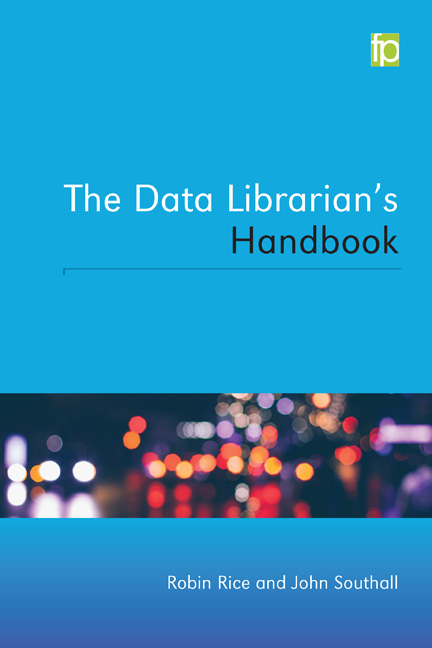Book contents
- Frontmatter
- Contents
- Acknowledgements
- Preface
- 1 Data librarianship: responding to research innovation
- 2 What is different about data?
- 3 Supporting data literacy
- 4 Building a data collection
- 5 Research data management service and policy: working across your institution
- 6 Data management plans as a calling card
- 7 Essentials of data repositories
- 8 Dealing with sensitive data
- 9 Data sharing in the disciplines
- 10 Supporting open scholarship and open science
- References
- Index
7 - Essentials of data repositories
Published online by Cambridge University Press: 08 June 2018
- Frontmatter
- Contents
- Acknowledgements
- Preface
- 1 Data librarianship: responding to research innovation
- 2 What is different about data?
- 3 Supporting data literacy
- 4 Building a data collection
- 5 Research data management service and policy: working across your institution
- 6 Data management plans as a calling card
- 7 Essentials of data repositories
- 8 Dealing with sensitive data
- 9 Data sharing in the disciplines
- 10 Supporting open scholarship and open science
- References
- Index
Summary
Repository versus archive?
What is a data repository and what is a data archive? We do not have any definitive answers and opinions often vary, but it is useful to note how the terms are used in practice. Certainly in one sense the two terms are synonymous. Each term carries with it certain implied characteristics, and is used within its own contexts and traditions. Social science data archives, as we discussed in Chapter 1, have a tradition going back decades. They can be established at various levels, most commonly national or sub-institutional, such as departmental. The term ‘archive’ to some implies rigorous long-term preservation procedures, and can also be associated with long-term storage that is not publicly accessible. In some cases these are collections intended to become open at some point in the future for legal reasons, also known as ‘dark archives’. To others, ‘archive’ is seen as a simple IT storage service akin to long-term back-up, but without any of the added curation that helps keep data usable and understandable over time and across communities (‘keeping the bits safe’). Of course the word archive is both a noun and a verb and the demand to ‘archive research data’ is a common one; but we suggest that on closer examination there is not enough shared understanding among communities about what it means to ‘archive your data’. For this reason we feel the term is best avoided, except as part of a name of a known institution.
Data repositories have a different provenance. Digital repositories came into fashion in the early 2000s to manage and disseminate publications and other types of digital assets. The use of ‘repository’ rather than ‘archive’ may in part indicate a desire to differentiate them from traditional physical archives managed within institutions. Electronic or digital repositories such as these were usually based on open source software such as DSpace, EPrints, Fedora and others, and were broadly established in institutions, championed by academic libraries in support of the open access movement. In addition to publications repositories, other specialist collections such as e-learning repositories began to flourish as well. Some repositories are subject-based, such as the well known arXiv service, established in 1991 for disseminating e-prints (electronic preprints) of scientific papers in the fields of mathematics, physics, astronomy, computer science and related fields.
- Type
- Chapter
- Information
- The Data Librarian's Handbook , pp. 103 - 120Publisher: FacetPrint publication year: 2016



